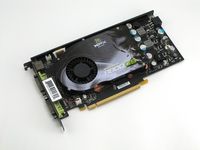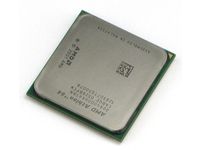Can Your Old Athlon 64 Still Game?
Gamers Have Plenty Of Upgrade Options
Before we get to performance testing, let’s take a quick look at some of the components in a gaming PC that will impact performance. In this article, we focus on systems that have a PCI Express slot, and therefore have an abundance of well-priced graphics card options available. The GPU is the most important and often underpowered system component for PC gaming. This is especially true if you purchased a pre-built system that might include an integrated graphics processor or a budget GPU not intended for any serious gaming. Often new system owners quickly discover their brand new machine is not very good for gaming due to a lack of graphics power.
The GeForce 8800 GS we chose for testing has been an amazing bargain in the United States. Re-branded as the 9600 GSO, these cards have recently retailed for as low as $50 after a mail-in rebate. It’s not as powerful as its bigger brother 8800 GT, but is far more powerful than the 8600 GT or the Radeon HD 2600 XT that used to occupy that same price range. Their low prices and capabilities make the 8800 GS and 9600 GSO good candidates for an older system that can handle a PCI Express 2.0 card. For those wanting even more GPU power, we also ran through our most demanding settings with another card that offers great value for the dollar, the AMD Radeon HD 4850.
However, the GPU is only part of the system requirements for enjoyable gaming. Faster hard drives can reduce load times. More memory means less pausing or stuttering from hard drive swapping. And, of course, a fast enough CPU to execute instructions and feed data to the graphics card is very important. We aim to find out if a single- or dual-core Athlon 64 has enough power to handle the latest games.
As far as the hard drive goes, there’s no real need to upgrade it unless you need more storage space, but it’s a good idea to keep it defragmented. On the memory side, 1 GB of RAM should be the minimum for Windows XP gaming, while 2 GB is better yet. Windows Vista owners should try to have at least 2 GB, if possible. Memory is in general very affordable now, so those with 1 GB or less should consider adding RAM to smooth out their game play.
CPU options come down to system compatibility and current availability. Many people have little upgrade options left in their system, and these gamers can use this article to see if it’s worth putting a new graphics card in their PC as is, or if it’s time to retire it and put the money towards a new system. For others, there may be processor upgrade options available, but are they a good place for the gamer to spend money? Will your system support dual-core CPUs? If so, are any available and are they reasonably priced? And are they fast enough to make a difference?
Those using Socket 754 motherboards are stuck with single-core processors, the fastest of which is a little slower than the single-core Athlon 64 we will use for this article. Our single-core CPU will represent the best performance you could hope to squeeze from your system. Socket 939 owners do have dual-core options, but they have long since been discontinued and are getting harder to find new. If you do find an affordable chip, most likely it’s a lower-clocked model like the one we have chosen for this article. Socket AM2 owners, on the other hand, have very affordable Athlon 64 X2 options available and are in a good position to upgrade their single-core or lower-clocked dual-core CPUs.
On the Intel side, Socket 478 owners are limited to single-core processors and are quickly seeing their systems barely meet the minimum specs as game boxes. LGA 775 owners need to be careful, as numerous dual-core options are available but support will vary depending on the specific motherboard and chipset. Regardless of the socket, if you consider a CPU upgrade, make sure to check with your motherboard/system manufacturer to see the list of supported CPUs.
Get Tom's Hardware's best news and in-depth reviews, straight to your inbox.
Current page: Gamers Have Plenty Of Upgrade Options
Prev Page Introduction Next Page Test System And Conditions-
Schip FIRST POST!!! Nice Article though. I knew my brother would soon be doomed with his P4 2.8c ;)Reply -
"AMD Athlon 64 X2 4200 + dual-core, which has a 2.2 GHz Manchester architecture with 512 MB L2 cache per core."Reply
oau! that's a lot of cache :D -
neiroatopelcc I haven't read the actual article yet, but I bet the simple answer is no!Reply
I've got a backup gaming rig at home that barely cuts it. An x2 1.9ghz (oc'ed to 2.4) with an 8800gtx and 3gb memory. That rig struggles at 1280x1024 in some situations, and it can only be attributed to the cpu really. -
bf2gameplaya 2.8GHz Opteron 185 (up from 2.6GHz) with 2x1MB L2 cache is the ultimate s939 CPU....blows these weak benchmarks away.Reply
Who would have thought DDR would have such durability? There's something to be said for CAS2! -
neiroatopelcc But your opteron cpu still limits the modern graphics cards.Reply
Two years back I bought my 8800gtx, and realized it wouldn't come to its full potential in my opteron 170 (@ 2.7). A friend with another gtx paired with an e6400 chip (@ 3ghz) scored a full 30% higher in 3dmark than I, and it showed in games. Even in wow where you'd expect a casio calculator would deliver enough graphics power.
In short - ye ddr still work if you've got enthusiast parts, but that can't negate the effect a faster cpu would give. At least at decent resolutions (22" wide) -
dirtmountain This is a great article! It will give me something to show when i'm talking to people about a new system or just a GPU/PSU upgrade. Great job by Henningsen.Reply -
NoIncentive I'm still using a P4 3.0 @ 3.4 with 1 GB DDR 400 and an nVidia 6800GT...Reply
I'm building a new computer next week. -
randomizer I can echo the findings in Crysis. It didn't matter what settings I ran with a 3700 Sandy and an X1950 pro, the framerate was almost the same (albeit low 20s because the card is slower). Added an E6600 to the mix and my framerate tripled at lower settings.Reply
It would have been interesting to see how a 3000+ Clawhammer (C0 stepping) would do in Crysis. Single-channel memory, poor overclocking capabilities... FAIL! -
ravenware bf2gameplaya2.8GHz Opteron 185 (up from 2.6GHz) with 2x1MB L2 cache is the ultimate s939 CPU....blows these weak benchmarks away.Who would have thought DDR would have such durability? There's something to be said for CAS2!Reply
Thia ia true about the DDR. I recall an article on toms right after the release of the AM2 socket which tested identical dual core processors against their 939 counterparts; the tests showed little to no performance gains.
Great article, their has been some discussion about this in the forums as well.
I currently own a 939 4200+ x2 that's paired with a 7800GT; and this article shows what I thought to be accurate about the AMD64 chips. Their not as fast as some of the C2D's but they still kick ass.
Good job pointing out the single core factor in newer games too. As soon as the crysis demo was released I upgraded my San Diego core to a dual core and noticed the difference in crysis immediately.
This article gives me further confidence in my decision to hold on upgrading my system. I want to hold out for Windows7 D3D11 and more money to build an ape sh** machine :D
Nice article!!


